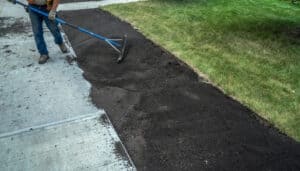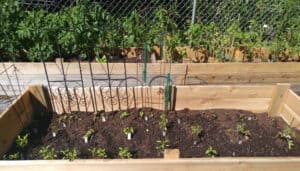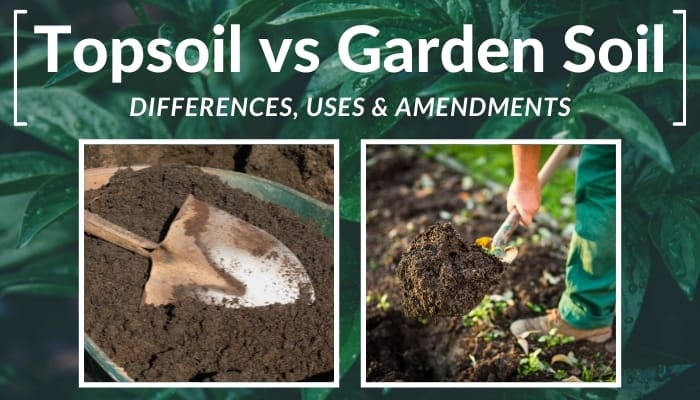Garden soil and topsoil may appear identical on the surface, but significant variations exist beneath their exterior.
Topsoil (the upper 5-10in / 12 -25cm of earth), is primarily managed to support landscaping plans and structural changes to the area. Garden soil enriched with organic compost and nutrients is typically placed on top of topsoil to support plant growth.
Key Takeaways
- Main Difference: Topsoil is the upper layer of the earth, less nutrient-rich, suitable for landscaping. Garden soil is enriched with organic matter, ideal for plant growth.
- Topsoil is best for leveling the ground, repairing lawns, and as a base for sod, while Garden Soil is ideal for flower beds, vegetable gardens, and potting mix enhancements.
- You can upgrade topsoil to garden soil, and for higher quality garden soil avoid compacting, and add nutrients to promote microbial growth like worm castings while avoiding harsh pesticides.

This article explains the difference between topsoil and garden soil. We’ll explore when to use topsoil, the advantages of garden soil, and practical tips for leveraging each type’s unique properties in your gardening endeavors.
Topsoil – Definition and Best Use
Topsoil is the top soil layer. It’s key for plant growth. This section looks at its types, uses in landscaping, and how to improve it.
What Is Topsoil?
Topsoil is the top 5 to 10 inches of earth. It’s fertile and has organic matter and minerals. (Utah State University Extension (USU)
While it’s less nutrient-dense than amended soils, its advantages include affordability and suitability for leveling and improving ground for initial landscaping.
However, you might need to add compost or fertilizer to make it better for some gardens.

When to Use Topsoil?
Topsoil is ideal for general landscaping projects, such as filling in low areas in yards, establishing raised beds, and serving as a base layer for laying sod.

Spread a thick layer on bad land to help it heal. It makes a stable base for new growth and shapes land for gardens and lawns. If you want to check the compaction level in your yard, it’s straightforward to do using a penetrometer.)
Using topsoil helps make a solid base for lawns and gardens. It’s good for plant roots. It’s the soil for basic landscaping and large-scale earthworks. On the other hand, if you need more nutrient-rich soil, consider amending topsoil with organic matter.
For help on how much topsoil to use for garden beds, check the Soil Calculations guide (Soil Calculations)
Topsoil – Different Types and Textures
Understanding the different types and textures of topsoil is crucial when considering when to use topsoil.
| Soil Type | Characteristics |
|---|---|
| Loamy | Rich in nutrients and moisture, ideal for most gardening needs |
| Sandy | Excellent drainage but fewer nutrients, suitable for plants preferring dry conditions |
| Clay | Retains water and nutrients well; its dense texture can impede root growth. Requires careful management to prevent root issues |
Each topsoil type plays a crucial role in Earth’s biological soil activity, influencing the biodiversity and health of the ecosystem.
For example, loamy soil is nutrient-rich and good for many soil microbes. This helps plants grow. Sandy soil drains well, affecting what lives in it.
Pro Tip: Ideally, mix all three topsoil types: loamy for nutrients and moisture, sandy for drainage, and clay for holding water.
Garden Soil – Definition and Best Uses
Garden Soil is a special mix of soil with organic matter and nutrients. It helps garden plants grow. It comes in different types for different plant needs, perfect for flower beds and vegetable gardens.
What Is Garden Soil?
Garden Soil is made for garden plants. It mixes topsoil with compost and helps plants grow by providing nutrients and moisture. It begins with topsoil and adds manure, fertilizers, or compost to make it better.
When to Use Garden Soil?
Garden soil is ideal for outdoor gardening projects, such as establishing flower beds, vegetable gardens, and landscaping areas.

Its rich composition, infused with organic matter and fertilizers, makes it perfect for nourishing plants that grow directly in the ground. Have a look at our related post on soil inoculants to get up to speed on this.
Use garden soil when amending existing soil in your garden to improve structure and fertility.
It’s also great for filling raised beds, where its nutrient-dense makeup supports healthy plant growth.
However, it’s not recommended for container gardening, as its density and moisture retention can be too heavy for potted plants.
Garden Soil – Different Types and Textures
Garden soil varies in composition and suitability for different gardening needs. One key factor is the presence and type of organic matter used, such as well-rotted, aged manure versus fresh manure.
| Type of Garden Soil | Composition | Best Use |
|---|---|---|
| Nutrient-Rich Soil | Well-rotted, aged manure and compost | Vegetable gardens, flower beds |
| Grainy Textured Soil | Balanced mix of compost and manure | Water-loving plants, areas with quick drainage |
| Denser Soil | Higher clay content, less compost | Plants requiring more water retention |
Different garden soils also have varying textures, from grainy to more solid compositions.
A grainy texture, achieved by a balanced mix of compost and manure, is ideal for retaining moisture while providing good aeration. This type of soil is excellent for water-loving plants and for use in areas with quick drainage.
In contrast, denser soils, which might contain clay, are better suited for plants that require more water retention and less frequent watering.
Pro Tip: Maintaining a balance of about 10% manure in compost creates an optimal mix for general garden use. This blend ensures the soil is rich in nutrients and has the right texture for a variety of plants
Best Soil Mix for Vegetable Garden
There is no one perfect recipe for Garden Soil. Generally, a mix of 60% Topsoil, 30% compost, and 10% potting soil works well. If your compost provider follows legal guidelines, you shouldn’t have a problem with pests and pathogens.
But the regulations don’t state how much bacteria and fungi you have to have in your compost. That means you could be buying dead, rotted waste material rather than living, thriving soil. If you’ve got fantastic compost that is full of beneficial organisms, you might be able to use much less than 30%.
Using potting soil is optional, but it improves drainage. This helps rainwater move through the soil better and reduces waterlogging. However, a balanced microorganism mix will naturally improve drainage.
Recommended Topsoil
Many online articles recommend topsoils for affiliate sales, but I’ll be honest. When it comes to topsoil, the more local, the better. We have a few more details for you to consider below, but be sure to skim our resource on the Best Topsoil for Vegetable Gardens for more info here.
If you get your soil flown in from another climate, it’s unlikely to be suitable for your conditions. This is because the microorganisms will be adapted to different conditions and may not survive in your yard. Otherwise, the long-distance transport could have wiped out all the life in your soil, which would be equally bad.
You should find a topsoil provider as locally as possible, which you can do by searching something like ‘Topsoil in Wyoming’ in Google. Ideally, you want organic topsoil, so you aren’t killing your existing microorganisms with pesticides.
Peat-free soil is always best because peat is a vital carbon sink and delicate habitat which the landscaping industry has overexploited. The industry is catching up now, and peat-free soils are increasingly available!
Recommended Garden Soil
If you cannot make your garden soil, you might like to try some Miracle-Gro All Purpose Garden Soil.
It contains plant food, which isn’t going to be necessary once you’ve restored your soil. (The plant food will be extracted from the soil particles by your biology).
But it’s a good idea to use some plant food at first because it will take time for your bacteria, fungi, and worms to move in. Some people complain that they see mushrooms growing in this potting soil and want a refund.
But that comes from a misunderstanding of how healthy soil functions and the role soil fungus plays.
If I see mushrooms growing around my garden, I pat myself on the back!
How to Turn Topsoil into Garden Soil?
How to turn topsoil into garden soil is an essential skill for enhancing our garden.
The key to transforming topsoil or garden soil lies in identifying and addressing the core issues at their foundation. Primarily, these challenges include soil compaction and a scarcity of beneficial microorganisms, crucial elements needed for a thriving garden.
In the following sections, we’ll explore effective strategies to tackle these issues, ensuring your garden has the best possible foundation.
Soil Compaction in Transforming Topsoil to Garden Soil
Soil compaction impedes water infiltration, leading to issues like topsoil erosion and inefficient water use. This problem often necessitates costly soil and plant replacements, as well as increased watering expenses.
To address soil compaction:
- Avoid using heavy machinery on the soil.
- Minimize or eliminate tilling, as it can exacerbate subsurface compaction.
- Implement regenerative farming techniques cover crops to protect soil from direct rain impact and reduce erosion.
By resolving compaction, plant roots can extend deeper, fostering healthier, more resilient growth over time.
How to Increase Beneficial Microorganisms in Topsoil?
Plants benefit immensely from the symbiotic relationships they share with soil-dwelling bacteria and fungi. These microorganisms aid in nutrient fixation, and water retention, and provide a natural defense against pests and diseases.
Additionally, soil organisms like protozoa and nematodes release nutrients in forms plants can easily absorb.
Beneficial bacteria an
Strategies to Boost Beneficial Microorganisms:
- Add quality compost, worm castings, and compost teas to introduce beneficial organisms.
- Avoid pesticides and fungicides that harm beneficial soil life.
- Adopt no-dig practices, as soil disturbance can destroy microbial communities.
Fostering a healthy microbial environment reduces the need for chemical treatments, cuts costs, and leads to stronger, more disease-resistant plants. Over time, this approach also naturally reduces weed problems, enhancing overall garden health and productivity.
Best Way To Improve Garden Soil
A thriving garden soil, much like topsoil, should be rich in microorganisms. While chemical or organic fertilizers offer short-term benefits, they can be costly and environmentally harmful. Overuse can lead to nutrient runoff, causing algae blooms in local water bodies, and harming wildlife.
The key to sustainable soil improvement lies in fostering a balanced microbial ecosystem. Microorganisms, such as fungi and bacteria, naturally bind soil and retain nutrients, reducing the need for additional fertilizers. They break down soil particles, releasing essential nutrients.
Practical Tips for Soil Improvement:
- Use compost tea or inoculate soil with beneficial fungi and microscopic predators to boost microbial activity
- Incorporate worm cast

This method not only enriches the soil but also ensures a more sustainable and environmentally friendly gardening practice. If you want to improve your garden soil with microorganisms, you can also spray it with compost tea or inoculate it with fungi and other microscopic predators.
Worm castings are also a brilliant way to improve your Garden Soil. You can even produce your own by using a vermicomposter. Just bear in mind that vermicompost (from worm bins) doesn’t heat up, so seeds can still be present.
So if you buy worm castings, they should have been heat-treated, so you don’t get random plants you didn’t bargain for popping up in your garden.
Other Soils Demystified: Potting Mix
In the diverse world of soils, potting mix stands out as a unique component, especially when compared to topsoil and garden soil. This introduction delves into how potting mix differs in composition and use, and the nuances of mixing it with topsoil and garden soil for various gardening applications.
Can You Mix Topsoil With Garden Soil?
If you’ve got fantastic Garden Soil, you can dilute it with Topsoil. We advise against mixing Garden Soil with Topsoil by tilling, as it harms microorganisms and fungi.
I know I keep going on about those tiny critters. But they are the key to thriving gardens, farms, and ecosystems.
It’s better to mix the soils in a bucket using a small spade. The concentration of each will depend on what you’re growing and the quality of your soil. It might take some experimenting, but that’s the joy of gardening!
Every year, you’ll need fewer soil amendments due to a healthy microorganism web in your soil. For more on the Soil Food Web, you’ll want to check out the work of Dr. Elaine Ingham.
More Questions About Soil Answered (FAQ)
Is Bagged Topsoil Any Good?
Bagged Topsoil can be perfectly alright, but it’s not always the best choice. With Topsoil, you want it to be as local as possible, so it has suitable microorganisms for your climate. If you’re covering a large area, it would be more economical to get a load trucked in rather than buying it by the bag.
Is It Cheaper To Buy Topsoil in Bulk?
It is almost always cheaper to buy topsoil in bulk, even once you pay transport fees. However, I recommend getting in touch with a local supplier for a quote because the price varies significantly.
What Does Good Garden Soil Look Like?
Good garden soil should be crumbly and dark brown. If it is black, then it probably doesn’t have enough oxygen. It doesn’t have to be completely uniform, but it should not have clumps of manure or identifiable organic matter.
Related Reading / Sources
- Soil Biology Primer, Dr. Elaine Ingham
- Teaming With Fungi, Jeff Lowenfels
- Teaming With Microbes, Jeff Lowenfels
- Mycorrhizal Planet: How Symbiotic Fungi Work with Roots to Support Plant Health and Build Soil Fertility, Micheal Phillips
- Growing a Revolution: Bringing Our Soil Back to Life, David Montgomery
- No Dig Gardening, Charles Dowding


